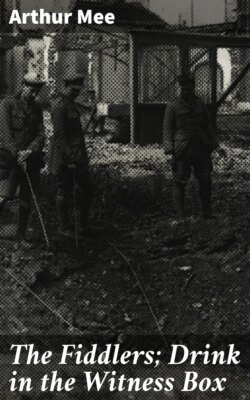Читать книгу The Fiddlers; Drink in the Witness Box - Arthur Mee - Страница 8
На сайте Литреса книга снята с продажи.
ОглавлениеThe Shadow of Famine
Table of Contents
The Government came into office with the food shortage in sight; it was its first duty to build up the great reserve of food we might have had now in our granaries if the drink trade had not destroyed it. We could have laughed at submarines, for our barns would have been filled to overflowing, and we could have lived in comfort for a year if no ship reached us.
Let us see how much food drink has destroyed during the war. We will take it from August 4, 1914, to April 30, 1917. It is 999 days of the war. The grain and sugar destroyed for drink have been:
| Grain | 4,400,000 tons |
| Sugar (for beer alone) | 340,000 tons |
How Canada sees it—A Canadian cartoon of the callous destruction of bread for beer and whisky
It is not easy to realize what this means, but it will help us if we think of one or two examples.
The biggest thing ever set up on earth is the Great Pyramid. It is 80,000,000 cubic feet. The food destroyed by drink during the war would make two Great Pyramids, each bigger than the Pyramid of Egypt.
The longest British railway is the Great Western; it is over 3,000 miles, but it would not hold the food destroyed by drink since war began. If every inch of it were crammed with wagons, the Great Western Railway would need hundreds of miles more line to hold the train-loads of food destroyed.
There are about 750,000 railway wagons in the United Kingdom, but if the Drink Trade had them all they would not hold the food it has destroyed.
There are about 30,000 engines on our British railways, and if the food destroyed were made up in trains of 125 tons apiece, all our engines would not pull them; we should still want 10,000 more.
So vast is this incredible quantity of food destroyed by an enemy trade while famine has been coming on. We should have saved it all if Parliament had followed the King, and it would have given the whole United Kingdom its flour rations for nearly a year. Take it at its minimum scientific human food value, and on the basis of our rations in May, 1917, it would have given us:
| Flour for the whole United Kingdom | 43 weeks |
| Sugar for the whole United Kingdom | 33 weeks |
Our three war Governments, confronted with the increasing certainty of at least a three-years’ war, have allowed the Drink Trade to destroy this vast reserve of food.
The full toll of this trade upon our scanty food supply, growing shorter and shorter while the queues outside our food shops grow longer and longer, is staggering indeed, even now with drink about three-quarters stopped. We must remember that it makes no difference that the barley has been malted; it is still good human food, and every ounce of it should be mixed with grain for making bread. Let us remember, also, that brewer’s sugar is a good pure sugar, the objection to it being largely the objection most of us have to standard bread—its colour. Malt or sugar, every ounce a brewer destroys is food stolen from the people. Let us take expert opinion on the subject.
The Food Value of Brewer’s Sugar
Table of Contents
We do not, of course, use this dark sugar when white sugar is cheap and easily procurable, but during the war we have used it for coffee, cocoa, and tea; and for puddings where colour did not matter. We have used it a good deal in our bakeries for chocolate goods, where colour again does not matter. It is a good, pure sugar, and the colour is the principal drawback.
Letter to Arthur Mee from a London caterer
The Food Value of Brewer’s Malt
Table of Contents
Malt flour can be used to make excellent cake with 50 per cent. wheat flour. It is sweet and pleasant to taste without the need of any sugar. Good scones can be made with 25 per cent. of malt flour. Its use in bread made with yeast causes too much fermentation in the bread, but it has no effect on baking-powder. The Food Controller’s Department is aware of the practicability of using malt flour, but the sale is restricted in order to limit its use for making beer. Brewers and maltsters are too patriotic to wish to use for beer what could be applied to food in case of a serious shortage, and the large stocks of barley and malt can supplement the supply of wheat flour.
Letter from a Brewer in the “Times,” April 11, 1917
Yet we have seen our Government holding up sugar for brewers; we have seen our Food Controller refuse to release a caterer’s sugar unless it were sold to a brewer; we have seen a Government short of food-ships bringing in brewers’ vats and casks of rum; and we see the Government still holding up this malt that would feed a people asking for more bread.
